About Skiing:
 |
| Its All About Skiing |
Skiing can be grouped into two general categories: Nordic and Alpine. Nordic skiing, the older of the two disciplines, originated in Scandinavia and uses free-heel bindings that attach at the toes of the skier's boots but not at the heels. Types of Nordic skiing include cross-country, ski jumping and Telemark. Alpine skiing (more often called "downhill skiing"), originated in the European Alps, and is characterized by fixed-heel bindings that attach at both the toe and the heel of the skier's boot.
Types of Skiing
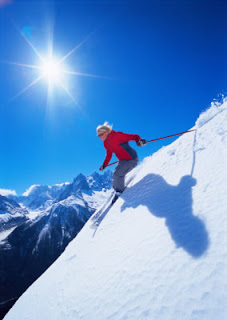 |
| Types of Skiing |
In skiing's traditional core regions in the snowy parts of Scandinavia, as well as in places such as Alaska, both recreational and competitive skiing is as likely to refer to the cross-country variants as to the internationally downhill variants.
Skiing techniques are difficult to master, and accordingly there are ski schools that teach everything from the basics of turning and stopping safely to more advanced carving, racing, mogul or "bump" skiing and newer freestyle techniques. There are two primary types of downhill skiing – "telemark" and "alpine."
For beginning skiers learning under a trained instructor, skiing speeds are low, the terrain is not steep and is often well-manicured, and the risks are relatively low. For extreme skiers, testing their expert abilities against ever more challenging terrain, the risks may be much higher.
Alpine Skiing (Downhill Skiing):
 |
| Alpine Skiing (Downhill Skiing) |
Freestyle Skiing:
 |
| Freestyle Skiing |
Alpine Freestyle: This kind of skiing employs the use of aerial acrobatics and balance, balance being necessary for rails. The use of rails is known as grinding or jibbing. Alpine freestyle was pioneered by Stein Eriksen in 1962. It developed in the 1970s into a style called Hotdogging. In this type of skiing, skiers use jumps (also called kickers or launches) or rails to do aerial tricks. These tricks are reinvented and progressed in technique and style every day.
Freestyle/Newschool: Freestyle skiing is the type of skiing with which tricks are usually associated. The skis used are generally of a twin tip design, which allow the rider to ride switch (backwards) more easily. Tricks are generally spins and flips, that can be conjoined with a grabbing of the ski to improve the image of the trick. Freestyle skiing generally takes place in terrain parks at ski resorts, with a wide variety of jumps, rails, jibs and other features to session. Mogul skiing is also considered as freestyle skiing.
Freeskiing/Freeride Related to freestyle skiing in nature is freeriding, which involves taking the tricks done in the park to the rest of the mountain and the backcountry. Thus, fatter skis may be used to float on top of the powder. Freeriding often involves steeps, cliffs, powder, and glades. In part due to the growing popularity of freestyle skiing in recent years and the obvious limitations in that aspect of the sport, freeride skiing has also been growing in popularity in recent years as more and more skiers have access to good backcountry gear and skis.
Nordic Skiing:
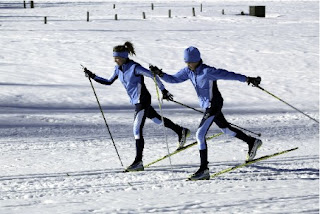 |
| Nordic Skiing |
Nordic jumping, also called ski-flying and ski jumping, is a competition in which skiers glide down a long ramp before becoming airborne. This is done with Nordic style skis, meaning that the heels of boot and binding are detached from the ski. The skis are much longer and wider than other types of skis and jumping is typically done without ski-poles.
Military Skiing:
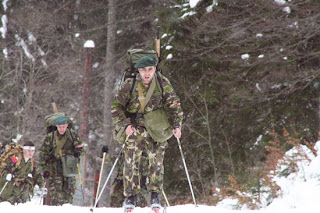 |
| Military Skiing |
Other Skiing Types:
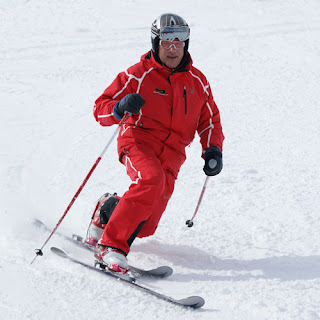 |
| Telemark Skiing |
Kite skiing is skiing done while being pulled or carried by a parasail, hang glider, or kite.
Water skiing is done on water and is where a skier is pulled by a leash attached to a boat, generally a speed boat, and the speed allows the skier to skim or ski across the water. Water skiing is also sometimes done with only one ski or sometimes no skis at all.
Paraskiing is accomplished either by jumping from a plane or starting from a high altitude on the ground (i.e. – from a mountaintop). Once the parachute is deployed, it is used heavily for steering. Paraskiing has been a competition sport for years, and can be scored for such things as speed and slalom accuracy. This is very different from kite-skiing, as gravity is the sole means of propulsion, rather than wind, thermals, or motors.
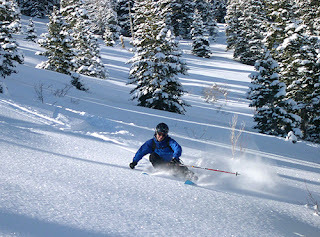 |
| Backcountry Skiing |
Skijoring, also called Euro-style mushing, is skiing while being pulled by an animal(s), typically dogs or horses, or by snow machine.
Dry Slope Skiing: This is skiing on artificial or dry snow, or dirt. Dry slope skiing is a year-round sport in countries like the UK where the snow cover is insufficient for traditional skiing. There is a thriving race programme on British slopes.
Adaptive skiing is skiing done by individuals with physical disabilities. Adaptations to standard ski equipment or accompaniment by a non-disabled guide has enabled individuals with amputations, spinal injuries, TBI, deafness and visual impairments to ski, and in some cases, even race. The venue, speed and technical difficulty associated with the sport can lead to collisions, accidents, hypothermia and other injury or illness, occasionally including death. Regional Ski Patrol organizations, such as the National Ski Patrol in the U.S., exist as a voluntary organization to provide guidance, help, medical assistance and emergency rescue to those in need of it.
Skiing Techniques:
Given below are techniques used by skiiers.
Carve Turn:
 |
| Carve Turn |
A carve turn is a skiing term, used to refer to a turning technique in which the ski shifts to one side or the other on its edges. In this case, the ski turns itself and is driven by the sidecut geometry while losing no speed, unlike a normal parallel turn.
Jump Turn:
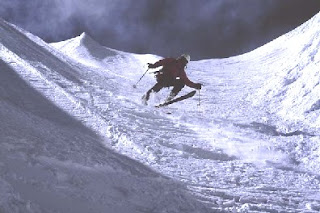 |
| Jump Turn |
A Jump turn is a skiing technique used in steep, narrow areas - such as a couloir - that do not permit a full parallel or carving turn. Jump turns involve pole planting followed by a quick hop that reverses the skiers' direction.
Parallel Turn:
 |
| Parallel Turn |
Parallel turns require solid contact from the skier's lower leg to the ski to rotate it on-edge. This was difficult to achieve with early ski equipment, limiting the technique to the high performance realm of racing. The introduction of composite skis, metal edges, releasable clamping bindings, and stiff plastic boots combined to allow parallel turns even on beginner equipment. By the late 1960s it rapidly replaced stemming for all but very short-radius turns. The evolution of shaped skis in the 1990s advanced the carving turn to preeminence.
Today parallel turns are taught to teach novice skiers the effect of weighting and unweighting their skis.
Basic Action: The parallel turn relies on two dynamics: turning the ski up on its edge and bending it at its center to create an arc.
The skier initiates the turn by moving their knees laterally in the direction of the desired turn. The motion of knees is translated through the calf to the high cuffs on the ski boots, through the boots to the bindings, and then to the skis. This causes the skis to rotate up on their edges, with the skier's weight and the force they put upon them bending the skis at their center into the arc that turns them. To stop the turn the knee is rotated back to the neutral position. While both skis take part, in practice the ski on the outside of the turn is dominant.
Moving the legs to the side shifts the center of gravity, compensated for by moving the hips in the opposite direction. The effect is to keep the skier's upper body upright while the lower torso and legs shift side-to-side. The skier pressures the front of their skis to keep the fore-and-aft center of gravity of the skier's mass over their toes.
The parallel turn can be improved through dynamic "weighting". Turns are often linked in a series of continual arcs, one direction then the other. Lifting the body through the middle of the switch partially releases the skis arcs, easing the transition to the opposite direction.
Changing Technique: Traditionally construction techniques produced skis with limited torsional strength. The minimal sidecut this permitted resulted in parallel turns of limited radius. Consequently, paralleling and stemming were mixed together depending on the situation. Often turns would be initiated parallel then evolve into stemming to create greater turning power - at the expense of both speed and increased effort.
In the 1990s skis were progressively widened at the tips and tails relative to the waist. Applying an edge of these "shaped" or "parabolic" skis brings a curved surface to the snow, resulting in a carve turn.
Pivot Turn:
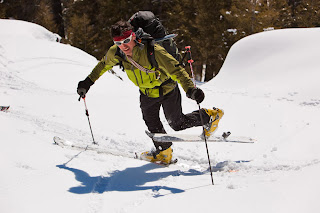 |
| Pivot Turn |
The pivot turn or pivot is a technique of turning in place in skiing. The two types are the tail pivot and tip pivot.
In the tail pivot, e.g., to the left, little turning steps are done to the left while keeping the tails of the skis together in place. Repeat the following two steps until the required amount of turn is reached: step the front of the left ski to the left with its tail in place, bring the right ski to the left ski. The tip pivot is similar, done while keeping the ski tips in place while moving the tails.
Snowplough Turn:
 |
| Snowplough Turn |
The snowplough turn (or snowplow turn) is a ski braking and turning technique taught to beginners. The front tips of the skis are brought together and the tails pushed wide apart, with the knees rolled inwards slightly. By applying pressure against the snow with the inside edges of the skis speed is reduced, making turning in such a configuration and stopping completely possible.
However, it is much less effective on steep runs, and much less efficient than the parallel turn used by advanced skiers.
Terminology:
- Uphill Ski refers to the ski that is in a position higher up the hill.
- Downhill ski refers to the ski that is in a position farther down the hill.
- Outside ski is the ski farthest away from the centre of the circle the skier is turning about.
- Inside ski is the ski closest to the centre of the circle the skier is turning about.
Once mastered the skier can move on to the somewhat more advanced turn, the Stem Christie.
Stem:
| Stem technique in skiing |
The stem technique in skiing is a method for turning the skier. It is usually credited to the Austrian Mathias Zdarsky who developed it in the 1890s. Its variations gradually replaced the telemark technique in Alpine skiing.
The technique involves stemming the uphill ski. Stemming is pushing the tail of the ski outward—skidding it across snow—from a parallel position with the downhill ski to form a V shape where the tips of the skis are close together and the tails far apart. Initially the stemming ski has relatively little pressure applied—much less than half the skier's weight. After the ski is stemmed, most of the skiers weight is then transferred to initiate a change in direction.
Stem Variants:
The variations of the stem turn are:
The Snowplough turn - (also known as the wedge turn or stem turn)
The Stem Christie
These variants form the basis of the Austrian Arlberg Technique and instruction system developed by Johannes Schneider.
Stem Christie: The stem Christie is a technique in skiing for turning. It is a refinement of the basic stem technique where, prior to the turn, the uphill ski is stemmed (tail skidded outward) from being parallel with the downhill ski to form a V shape.
The turn was named after Kristiania (now Oslo), Norway, where the name Kristianiasving was used for the parallel turn, differentiating it from the Telemark turn.
The technique was introduced to central Europe in 1910 by the Austrian ski guide Johannes Schneider. Along with the other two stem techniques, it formed the basis of his Arlberg technique and instruction method.
The technique was popular and widely used up until the late 1960s, when its use diminished in favor of the parallel turn, inspired mostly by ski racers. Radical side-cut skis, developed in the late 1990s, have accelerated the obsolescence of the stem Christie. It is still occasionally taught to intermediate and advanced skiers to demonstrate the difference in efficient movements with less efficient movements.
Terminology:
- Uphill Ski refers to the ski that is in a position higher up the hill.
- Downhill ski refers to the ski that is in a position farther down the hill.
- Outside ski is the ski farthest away from the center of the circle the skier is turning about.
- Inside ski is the ski closest to the center of the circle the skier is turning about.
Technique:
Having brought the skis into the V shape mentioned above, more pressure is applied to the uphill (or outside) ski which causes the skier to turn in the other direction.
Once the turn has commenced, the new uphill ski is stepped (lifted and rotated) to be parallel with the stemmed ski as the turn is made so that at the end of the turn both skis are parallel and pointing in the new desired direction of travel.
When properly applied, the leading stem on the outside ski is blended seamlessly into the lifting of the inside ski. In this case the skis will remain parallel throughout the turn. A perfect stem christie is thus difficult to distinguish, visually, from a true parallel turn. The techniques are very different in action, however. The stem christie is applied largely by shifting weight onto the uphill ski to start the stem, while the parallel turn is started by moving the lower leg to roll the ski onto its edge. Parallel turns are often helped by lifting weight off both skis to help initiate the turn, further confusing the two techniques as seen by an outside observer.
Ski Simulator:
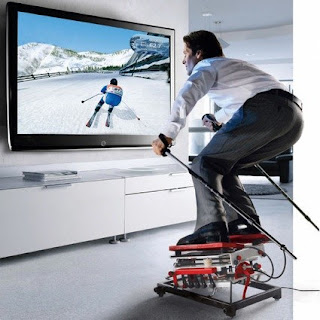 |
| Ski simulator |
There are many revolving carpet ski simulators and indoor ski slope carpets around the world. They can be used for introductory training or to improve on and hone skills for expert skiers, especially in the off season.
Balance, control and strength are learned by practice and actively doing training drills and lessons on the ski simulators.
Ski Equipments:
Ski:
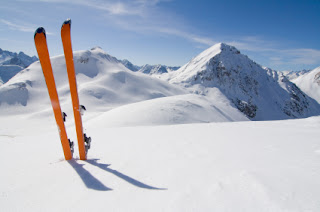 |
| Ski |
Originally intended as an aid to travel over snow they are now mainly used recreationally in the sport of skiing.
Skis are also fitted to vehicles dedidcated to traveling over snow such as snowmobiles and snowcats.
Types of Ski:
Many types of skis exist, designed for different needs, of which the following are a selection.
Alpine Ski: Like all skis, the original alpine "downhill" skis were little more than wood planks. Early alpine skis, developed in Switzerland and Austria during the 1890s, were wider, shorter versions of the standard Huitfeldt Telemark model, meant to be more agile in steep terrain and in deeper snow. Rudolf Lettner of Salzburg began marketing steel edges in 1928, enabling the ski to grip on hard snow ice. The following year Guido Reuge introduced the Kandahar binding, providing for heel lock-down and improved control for downhill skiing. Downhill ski construction has evolved into much more sophisticated technologies. The use of composite materials, such as carbon-Kevlar, made skis stronger, lighter, and more durable.
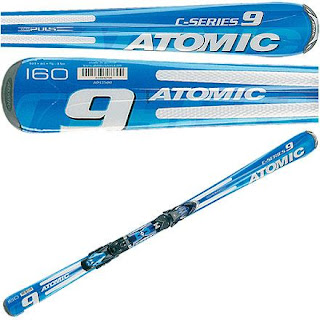 |
| Alpine Ski |
Skis used in downhill race events are longer, with a subtle side cut, built for speed and wide turns. Slalom skis; as well as many recreational skis ;are shorter with a greater side cut to facilitate tighter, easier turns. Many ski manufacturers label their skis with the turning radius on the top. For a racing slalom ski, this can be as low as 12 metres and for Super-G they are normally at 33 metres. For off-piste skis the trend is towards wider skis that better float on top of powder snow.
The ski is turned by applying pressure, rotation and edge angle. When the ski is set at an angle the edge cuts into the snow, the ski will follow the arc and hence turn the skier; a practice known as carving a turn. While old fashioned "straight skis" which had little side cut could carve turns, great leg strength was required to generate the enormous pressure necessary to flex them into a curved shape, a shape called reverse camber. When a modern ski is tilted on to its edge, a gap is created between the ground and the middle of the ski (under the binding) as only the sides near the tip and the tail touch the snow. Then, as the skier gently applies pressure, the ski bends easily into reverse camber.
Influenced by snowboarding, during the 1990s the side cut became significantly more pronounced to make it easier for skiers to carve turns. Such skis were once termed carving skis, shaped skis, or parabolic skis to differentiate them from the more traditional straighter skis, but nearly all modern recreational skis are produced with a large degree of side cut.
Reverse Camber Ski:
 |
| Reverse Camber Ski |
Reverse Camber is a term that describes skis with something other than the traditional camber shape. Reverse camber skis have tips and tails that curve up while the length between them is flat. This allows the ski tip to remain above soft powder snow. The first production ski to feature reverse camber was the Volant Spatula which premiered in the 2002–2003 season. Since then, many manufacturers have experimented with the concept and today rocker and reverse camber can be found in dozens of ski models.
Twin-Tip Ski:
 |
| Twin-Tip Ski |
In the past five years twin tips have become popular among youth skiers, ages 14–21. The popularity explosion of twin-tip skis created a push for the inclusion of more terrain park elements at ski areas. Once considered a passing fad, twin-tip skis have become a staple in the product line of all major ski-producing companies worldwide, with a few specializing in twin tips. Line Skis, started by Jason Levinthal, was the first company to market only twin-tip skis. The first twin-tip ski was the Olin Mark IV Comp introduced in 1974. The first company to successfully market a twin-tip ski was Salomon, with their Teneighty ski. While the first person to first introduce the Twin-tip to Salomon was famous Freeskier "Michael Douglas". These skis are used by freestylers also known as freeskiers.
Alpine Touring Ski:
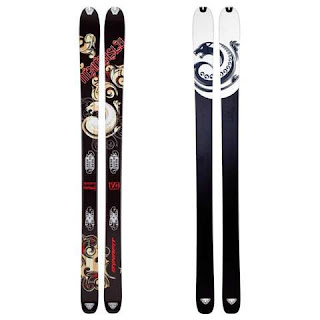 |
| Alpine Touring Ski |
The Alpine touring ski is a modified lightweight downhill ski with an alpine touring binding. Like the backcountry ski, it is designed for unbroken snow. For climbing steep slopes, skins (originally made of seal fur, but now made of synthetic materials) can be attached at the base of the ski. The heel of the ski boot can be clamped to the ski when skiing downhill and released when climbing. The type of ski is mainly used with alpine touring boots, which are rigid but lighter than downhill skiing boots, but may be fixed with a binding suitable for skiing in technical mountaineering boots.
Monoski:
| Monoski |
The monoski is wide enough to attach both boots to a single ski. After a brief boom in the 1980s, only a few thousand enthusiasts continue to use it. Due to its extra width and flotation in deep snow, enthusiasts claim it to be a superior powder ski. The monoski is produced by a half dozen companies worldwide in limited quantities.
Telemark Ski:
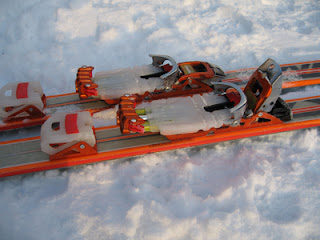 |
| Telemark Ski |
The Telemark ski is a downhill or touring ski, where the binding attaches only at the toe. The Telemark ski was the first ski with a significant side cut, and evolved in the Telemark region of southern Norway early in the 19th century. It was popularized by Sondre Norheim of Morgedal in Telemark, when he demonstrated the ski and the Telemark style of skiing to the public at Christiana, Norway beginning in 1868. The fact that the foot is only attached to the ski at the toes means that flexible ski boots are worn. The primary turning technique involves pushing one foot forward and lifting the heel of the other foot.
Cross-Country Ski:
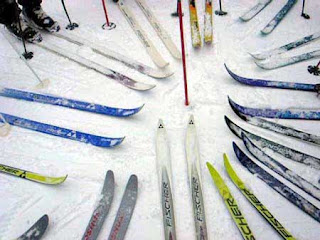 |
| Cross-Country Ski |
The ski bases are waxed to reduce friction during forward motion, and kick wax can also be applied for adhesion when walking uphill. Some waxless models may have patterns on the bottom to increase the friction when the ski slides backward.
The two major techniques are classical (traditional striding) and freestyle or skating, which was developed in the 1980s. Skating skis are shorter than classical skis and do not need grip wax. The skating technique is used in biathlons. V1 skating is done when going up a hill and one arm is the lead arm which poles ahead of the second with its side. V2 skating is done while going down a hill or on a flat area. It involves poling with every stride of the ski.
Backcountry Ski:
 |
| Backcountry Ski |
Skis for backcountry skiing (also known as free range and Big Mountain skis) are designed for unbroken snow where an established track is lacking. Employed by military forces to fight in winter conditions, they are the most closely related modern type to the original ski.
Characteristically 10 cm or more in width, they're often fitted with cable bindings to provide general sturdiness and to make it easier to extract one's feet from deep snow banks, in case it should be impossible to reach the bindings by hand.
Mogul Ski:
 |
| Mogul Ski |
Skis specifically designed for moguls typically have a different flex pattern, are narrower, and have a smaller sidecut than a common carving ski. The differences let the ski absorb the impact of the moguls with the tip yet have a tail stiff enough to push off the previous mogul.
Jumping: Skis for ski jumping. Long and wide skis, with bindings attaching at the toe.
Custom Ski:
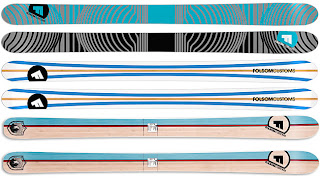 |
| Custom Ski |
Since 2004 a few small companies have emerged in the United States making custom skis. The process begins with a questionnaire and interview to determine what flex, materials and ski shape will best suit the skier's skills, weight and target snow and terrain. Core materials, structural components, base and edge materials can be of superior quality and durability. Customers often design their own decorative topsheets.
Ski Pole:
 |
| Ski Pole |
In the days before turning techniques had been properly developed, skiers would use poles for hunting: one pole would be for balance/braking and the other pole would have a sharpened tip or a spear head to be used as a spear.
In modern skiing one pole is held in each hand. Near the end of the shaft, there is a circular "basket" attached to stop the pole from sinking significantly into deep snow. These can range from being small, aerodynamic cones used in racing, to large snowflake shaped baskets which are used in powder skiing. Attached to the upper part of the pole is a grip with a strap, either fastened to the pole or detachable. These are usually slipped over the wrist to improve the skiers hold on the grip and to prevent the loss of the pole in the event of a fall. On most poles, the straps, grips, baskets and ferrules (metal tips) are replaceable. When skiing backcountry (off piste), the wrist strap is not normally used, because there is a risk of wrist injury if the pole should catch on an unseen branch or root. Ski jumping, ski carving, aerials and skiboarding are the only types of skiing in which no poles are used.
Poles are used in cross-country skiing to enable the user to gain more speed than by using the skis alone, as well as offering improved balance. In Nordic racing, poling technique is essential, especially so during a mass start in which double-poling is the main means of propulsion.
Alpine skiers use poles as well. While they serve the same purposes as they do in cross country, they can also help with the timing of the more advanced ski turns. By making contact with the ground between each turn in a process known as "pole planting", alpine skiers are given greater stability as they move their mass down the hill, creating more acceleration and a tighter turning radius.
Types of Ski Pole:
Alpine Ski Pole:
 |
| Alpine Ski Pole |
In competitive alpine skiing, including high speed disciplines such as Giant Slalom, Super Giant Slalom, Downhill, and Speed Skiing poles may be designed to bend around the skiers body while in a tuck position, in order to minimize air drag. In Slalom skiing, regular straight poles are preferred due to the reduced speeds and increased reliance on poles.
Nordic Ski Pole:
 |
| Nordic Ski Pole |
Nordic ski poles (used for cross-country, biathlons, etc...) are longer than poles used for alpine skiing. Poles used for freestyle are longer than those used for classical skiing. Basket styles at the bottom of the pole vary by pole use. Back-country poles designed for use in deep snow will have a larger basket design, while a racing pole will have a small, lightweight basket. Back country or touring poles may be telescopic so they can be adjusted to snow conditions and/or the steepness of the slope.
Ski Boot:
 |
| Ski Boot |
Ski boots were originally made of leather and resembled standard winter boots. As skiing became more specialized as a form of recreation, so too did ski boots, leading to the splitting of designs between those for alpine skiing (downhill) and cross-country skiing. The latter remain similar to standard footwear, but include an attachment point for the bindings near the toe. The former have become much more specialized, rising up the leg in order to transmit sideways rotations of the legs through the bindings and into the skis, a process known as "edging". A variety of techniques combine features of cross-country and downhill, notably Randoneé, and Telemark, and have led to further customization of boot styles to fill these niches.
Ski Suit:
 |
| Ski Suit |
A ski suit can either be one-piece, in the form of a jumpsuit, or two-piece, in the form of a ski jacket and matching trousers, called salopettes (or ski pants).
A ski suit is made from wind- and water-resistant or water-proof fabric, and has a non-removable liner made of nylon, silk, cotton or taffeta. Its main function is to keep a person warm while participating in winter sports, especially Nordic (cross-country) or Alpine (down-hill) skiing. It is generally a unisex garment.
A ski suit is usually made to keep the body warm (sometimes partly due to a suitable silvery colour that as a result increases its thermal conductivity), but the user often wears warm underwear too. It can also be used for alpine racing to improve aerodynamics. Ski suits made for speed skiing and alpine skiing might be very thin and skintight, adding as little air resistance as possible to the body.
Ski Jacket:
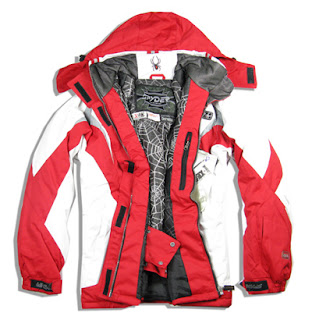 |
| Ski Jacket |
From the introduction of ski jackets in the middle to late 1950s through the early 1980s, the dominant style was for a ski jacket to resemble a safari jacket in having a similar belt and shirt-like collar.
A similar garment, especially one with a hood, may be called a parka, anorak, down jacket or winter shell.
Ski Binding:
 |
| Ski Binding |
A ski binding is an attachment which anchors a ski boot to the ski. There are different types of bindings for different types of skiing.
Types of Ski Binding
- Universal Designs
- Alpine
- Cross Country
- Telemark
- Skiboard and Snowblade Non-Release Binding
Ski Helmet:
 |
| Ski Helmet |
A ski helmet or snowboard helmet is a protective head covering specifically designed and constructed for wintersports, often insulated against cold weather. Design includes the ability to withstand multiple impacts. This protective gear comes in different styles and types - full shell, short shell, and full face models. A ski helmet must be properly fitted to provide maximum protection, performance and comfort.
In addition to providing protection, some newer helmets come with built-in earpad speakers for listening to portable music devices.
Ski Goggles:
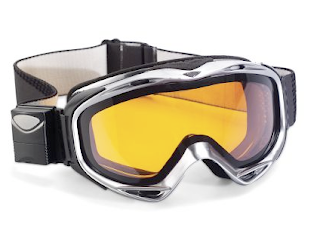 |
| Ski Goggles |
Protect the eyes from glare and from icy particles flying up from the ground. Double lens anti-fog ski goggles were invented and patented by Robert Earl "Bob" Smith.
Ski Gloves:
 |
| Ski Gloves |
Ski gloves are padded and reinforced to protect from the cold but also from injury by Skis.
Ski Resort:
A ski resort is a resort developed for skiing and other winter sports. In Europe a ski resort is a town or village in a ski area - a mountainous area, where there are ski trails and supporting services such as hotels and other accommodation, restaurants, equipment rental and a ski lift system. In North America it is more common for ski areas to exist well away from towns, and the term ski resort is used for a destination resort, often purpose-built and self-contained, where skiing is the main activity. The term ski station is also used, particularly in Europe, for a skiing facility which is not located in or near a town or village
Ski areas have marked paths for skiing known as runs, trails or pistes. Ski areas typically have one or more chairlifts for moving skiers rapidly to the top of hills, and to interconnect the various pistes. Rope tows can also be used on short slopes (usually beginner hills or bunny slopes). Larger ski areas may use gondolas or aerial trams for transportation across longer distances within the ski area.
Some ski resorts offer lodging options on the slopes themselves, with ski-in and ski-out access allowing guests to ski right up to the door. Ski resorts often have other activities, such as snowmobiling, sledding, horse-drawn sleds, dog-sledding, ice-skating, indoor or outdoor swimming, and hottubbing, game rooms, and local forms of entertainment, such as clubs, cinema, theatre and cabarets.
Though skiing is less dangerous than many popular sports (such as bicycling, golf, football, swimming, and weightlifting), it is widely perceived as being high risk, in part due to significant accident rates as recently as the 1970s. Nevertheless, ski areas usually have at least a basic first aid facility, and some kind of ski patrol service to ensure that injured skiers are rescued. The ski patrol is usually responsible for rule enforcement, marking hazards, closing individual runs (if a sufficient level of hazard exists), and removing (dismissing) dangerous participants from the area.
A ski resort which is also open for summer activities is often referred to as a mountain resort.